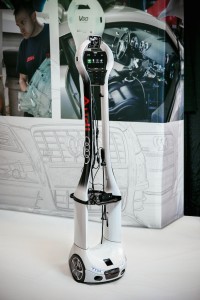
Audi is helping it service technicians get a second opinion and other insight with its new ART: Audi Robotic Telepresence.
In the Star Wars series, Luke Skywalker had R2-D2 to help him solve problems and now service technicians at Audi dealerships across the U.S. are getting ART: Audi Robotic Telepresence.
ART is a robot on a remote-controlled white stand that uses multiple cameras, a microphone and speakers operated remotely by Audi Technical Assistance consultants and Technical Field Managers.
The robot allows on-site techs to get additional opinions on problems. Among the multiple cameras is a one small enough to be used in tiny holes as well as a borescope allowing the off-site personnel to get a full view of what’s going on with the vehicle.
“ART was designed with both Audi technicians and consumers in mind,” said Brian Stockton, general manager, Technical Support, Audi of America. “The device will give local service technicians valuable one-on-one interaction with their counterparts at Audi of America, which will not only benefit the speed and depth of service at the dealer level, but create an improved ownership experience for the customer in general.”
(How to save fuel in hot weather. For more, Click Here.)
ART is being piloted in 18 dealerships in Minnesota, New Hampshire, Texas, Arizona, Florida, Michigan, Virginia, Washington, Ohio, Connecticut, New Jersey, Colorado, California and Illinois, but the expectation is to grow that number to 100 in the near future.
(Click Here for details about the Cadillac losing another top exec.)
The system was developed by the Audi Technical Support team in conjunction with VGo Communications, which has developed similar technology for healthcare, education and other industries.
(To see more about BMW looking to cut more than $5 billion in costs, Click Here.)
However, the ART user interface system, including the screen, handheld camera, and borescope, is unique to Audi because a dealership is a little different environment. Audi and VGo are researching new tools and accessories to improve ART’s capabilities.

I hope it helps because most newer vehicles are almost impossible to work on due to so much hardware crammed into such small spaces. Everything requires a diagnostic computer connection as most everything in the vehicle is microprocessor controlled. In addition when the components and systems are designed they really are not designed to be serviced as the designers are required to fit 10 lbs. of hardware in a 5 lb. space.